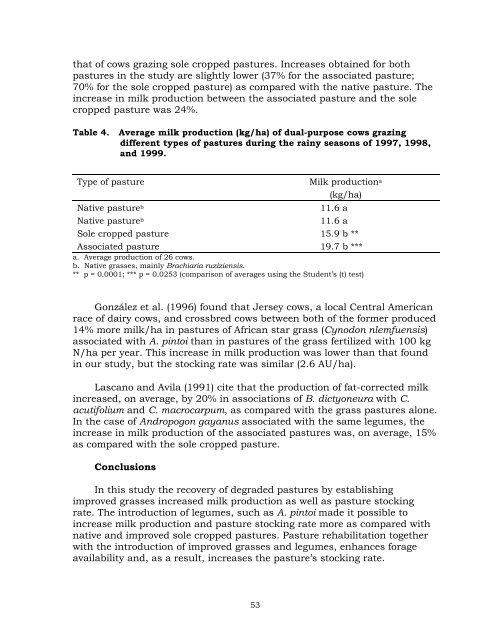Feeding Systems with Legumes to Intensify Dairy Farms - cgiar
Feeding Systems with Legumes to Intensify Dairy Farms - cgiar
Feeding Systems with Legumes to Intensify Dairy Farms - cgiar
Create successful ePaper yourself
Turn your PDF publications into a flip-book with our unique Google optimized e-Paper software.
that of cows grazing sole cropped pastures. Increases obtained for both<br />
pastures in the study are slightly lower (37% for the associated pasture;<br />
70% for the sole cropped pasture) as compared <strong>with</strong> the native pasture. The<br />
increase in milk production between the associated pasture and the sole<br />
cropped pasture was 24%.<br />
Table 4. Average milk production (kg/ha) of dual-purpose cows grazing<br />
different types of pastures during the rainy seasons of 1997, 1998,<br />
and 1999.<br />
Type of pasture Milk productiona (kg/ha)<br />
Native pastureb 11.6 a<br />
Native pastureb 11.6 a<br />
Sole cropped pasture 15.9 b **<br />
Associated pasture 19.7 b ***<br />
a. Average production of 26 cows.<br />
b. Native grasses, mainly Brachiaria ruziziensis.<br />
** p = 0.0001; *** p = 0.0253 (comparison of averages using the Student’s (t) test)<br />
González et al. (1996) found that Jersey cows, a local Central American<br />
race of dairy cows, and crossbred cows between both of the former produced<br />
14% more milk/ha in pastures of African star grass (Cynodon nlemfuensis)<br />
associated <strong>with</strong> A. pin<strong>to</strong>i than in pastures of the grass fertilized <strong>with</strong> 100 kg<br />
N/ha per year. This increase in milk production was lower than that found<br />
in our study, but the s<strong>to</strong>cking rate was similar (2.6 AU/ha).<br />
Lascano and Avila (1991) cite that the production of fat-corrected milk<br />
increased, on average, by 20% in associations of B. dictyoneura <strong>with</strong> C.<br />
acutifolium and C. macrocarpum, as compared <strong>with</strong> the grass pastures alone.<br />
In the case of Andropogon gayanus associated <strong>with</strong> the same legumes, the<br />
increase in milk production of the associated pastures was, on average, 15%<br />
as compared <strong>with</strong> the sole cropped pasture.<br />
Conclusions<br />
In this study the recovery of degraded pastures by establishing<br />
improved grasses increased milk production as well as pasture s<strong>to</strong>cking<br />
rate. The introduction of legumes, such as A. pin<strong>to</strong>i made it possible <strong>to</strong><br />
increase milk production and pasture s<strong>to</strong>cking rate more as compared <strong>with</strong><br />
native and improved sole cropped pastures. Pasture rehabilitation <strong>to</strong>gether<br />
<strong>with</strong> the introduction of improved grasses and legumes, enhances forage<br />
availability and, as a result, increases the pasture’s s<strong>to</strong>cking rate.<br />
53
















